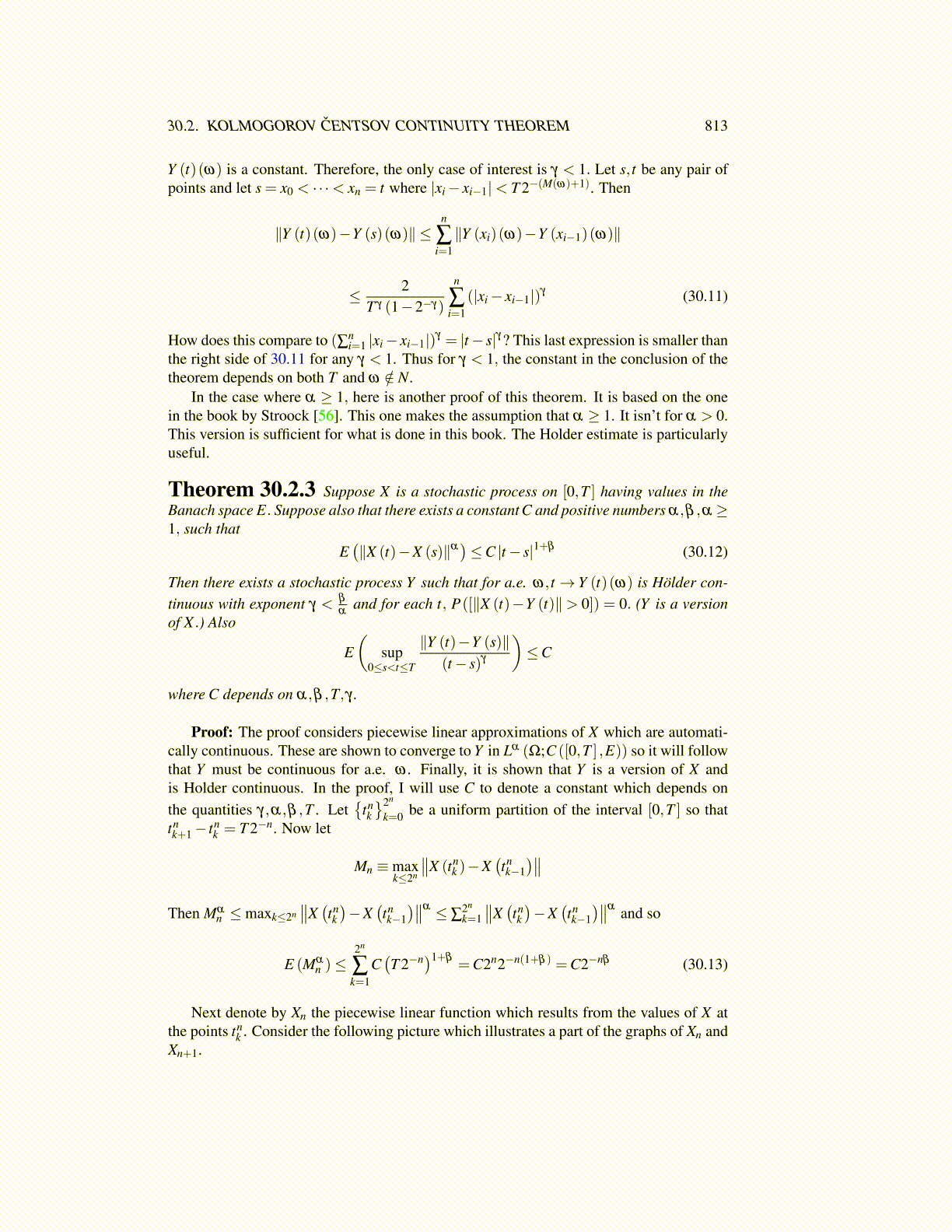
30.2. KOLMOGOROV ČENTSOV CONTINUITY THEOREM 813
Y (t)(ω) is a constant. Therefore, the only case of interest is γ < 1. Let s, t be any pair ofpoints and let s = x0 < · · ·< xn = t where |xi− xi−1|< T 2−(M(ω)+1). Then
∥Y (t)(ω)−Y (s)(ω)∥ ≤n
∑i=1∥Y (xi)(ω)−Y (xi−1)(ω)∥
≤ 2T γ (1−2−γ)
n
∑i=1
(|xi− xi−1|)γ (30.11)
How does this compare to (∑ni=1 |xi− xi−1|)γ = |t− s|γ ? This last expression is smaller than
the right side of 30.11 for any γ < 1. Thus for γ < 1, the constant in the conclusion of thetheorem depends on both T and ω /∈ N.
In the case where α ≥ 1, here is another proof of this theorem. It is based on the onein the book by Stroock [56]. This one makes the assumption that α ≥ 1. It isn’t for α > 0.This version is sufficient for what is done in this book. The Holder estimate is particularlyuseful.
Theorem 30.2.3 Suppose X is a stochastic process on [0,T ] having values in theBanach space E. Suppose also that there exists a constant C and positive numbers α,β ,α ≥1, such that
E(∥X (t)−X (s)∥α
)≤C |t− s|1+β (30.12)
Then there exists a stochastic process Y such that for a.e. ω, t → Y (t)(ω) is Hölder con-tinuous with exponent γ < β
αand for each t, P([∥X (t)−Y (t)∥> 0]) = 0. (Y is a version
of X .) Also
E(
sup0≤s<t≤T
∥Y (t)−Y (s)∥(t− s)γ
)≤C
where C depends on α,β ,T,γ .
Proof: The proof considers piecewise linear approximations of X which are automati-cally continuous. These are shown to converge to Y in Lα (Ω;C ([0,T ] ,E)) so it will followthat Y must be continuous for a.e. ω . Finally, it is shown that Y is a version of X andis Holder continuous. In the proof, I will use C to denote a constant which depends onthe quantities γ,α,β ,T . Let
{tnk
}2n
k=0 be a uniform partition of the interval [0,T ] so thattnk+1− tn
k = T 2−n. Now let
Mn ≡maxk≤2n
∥∥X (tnk )−X
(tnk−1)∥∥
Then Mαn ≤maxk≤2n
∥∥X(tnk
)−X
(tnk−1
)∥∥α ≤ ∑2n
k=1
∥∥X(tnk
)−X
(tnk−1
)∥∥α and so
E (Mαn )≤
2n
∑k=1
C(T 2−n)1+β
=C2n2−n(1+β ) =C2−nβ (30.13)
Next denote by Xn the piecewise linear function which results from the values of X atthe points tn
k . Consider the following picture which illustrates a part of the graphs of Xn andXn+1.